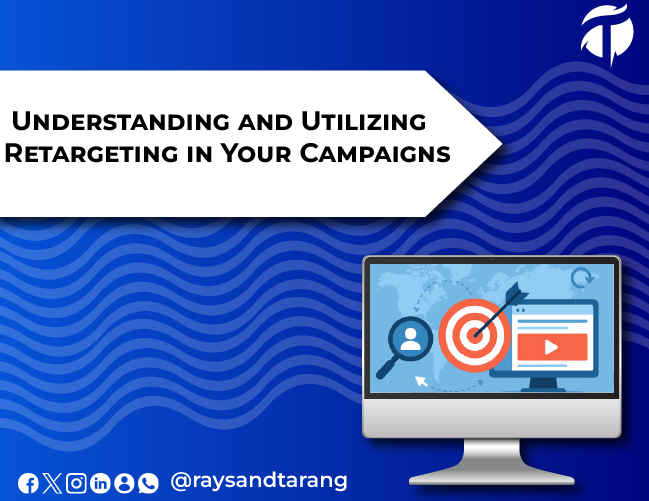Introduction
In the ever-evolving digital landscape, customer attention spans are short, and competition is fierce. Even after investing time and money in ads, many visitors leave your website without taking any action. That’s where retargeting steps in as a game-changer.
What is Retargeting in Digital Marketing? Simply put, retargeting allows you to reach users who have previously interacted with your website or ads, nudging them to return and complete a desired action.
This blog offers a detailed, easy-to-understand guide on how to use retargeting in your ad campaigns, including benefits, platforms, implementation, and how RAYS and TARANG Technologies LLP can help you build effective retargeting strategies tailored to your brand.
What is Retargeting in Digital Marketing?
Retargeting is a form of online advertising that helps brands reconnect with users who previously visited their site but didn’t convert. This is done by placing a small piece of code—often called a tracking pixel—on your website to follow users across the web and serve them relevant ads.
It’s not just about bringing users back. It’s about reminding, persuading, and guiding them through the customer journey until they take action.
How Retargeting Works: A Simple Breakdown v;
Once someone visits your website, your tracking pixel drops a cookie into their browser. This cookie tells advertising platforms (like Facebook, Google Display Network, or LinkedIn) to show your ads to that user across other websites and apps.
Example: A user visits your product page, adds something to the cart, but doesn’t purchase. Later, while browsing the news, they see your ad offering a 10% discount—this is retargeting in action.
Benefits of Retargeting
- Increases conversion rates by re-engaging warm audiences.
- Improves ROI by targeting users who already showed interest.
- Enhances brand recall by keeping your business top-of-mind.
- Boosts sales funnel performance from awareness to purchase.
Retargeting isn’t just about ads—it’s about personalized engagement at scale.
Remarketing vs. Retargeting: What’s the Difference?
While often used interchangeably, there’s a slight difference:
- Retargeting usually refers to display ads and uses cookies.
- Remarketing often refers to re-engagement via email marketing.
Both aim to re-engage lost leads and are highly effective when used together.
Effective Retargeting Techniques
- Dynamic Ads: Show products or content based on past behavior.
- Custom Audiences: Segment users based on actions—like visited product pages or cart abandoners.
- Frequency Caps: Avoid ad fatigue by limiting the number of impressions.
- Cross-Platform Retargeting: Sync efforts across Facebook, Instagram, YouTube, and Google.
Learn more about these techniques in our Performance Marketing solutions.
How to Use Retargeting in Your Ad Campaigns (Step-by-Step Guide)
- Install Pixel Tracking (Facebook Pixel, Google Tag, etc.)
- Segment Your Audiences (site visitors, cart abandoners, blog readers)
- Create Custom Ad Creatives for each segment
- Set Frequency & Budget Controls
- Run A/B Tests to optimize performance
- Monitor ROI and Adjust
Need help setting this up? Our Web Development team can help you integrate your pixel tracking correctly.
Retargeting Platforms to Consider
- Google Display Network
- Meta Ads (Facebook & Instagram)
- LinkedIn Ads
- YouTube Ads
- Programmatic Ad Networks (like AdRoll)
Each platform has its unique strength. Google excels in reach, while Meta is excellent for engagement and visuals.
Retargeting for eCommerce and B2B Campaigns
- eCommerce: Use dynamic product ads for abandoned cart recovery.
- B2B SaaS Example: A software company ran retargeting campaigns for users who signed up for a demo but didn’t convert. By showing testimonial ads and time-limited offers, conversions increased by 42%.
Want similar results? Connect with our Digital Branding team.
Common Mistakes in Retargeting Campaigns
- Not segmenting audiences.
- Showing the same ads repeatedly (ad fatigue).
- Poor landing page experience.
- Ignoring mobile optimization.
Avoiding these pitfalls ensures better engagement and improved ROI.
Measuring Success & Improving ROI with Retargeting
Key Metrics:
- Click-Through Rate (CTR)
- Conversion Rate
- Cost per Acquisition (CPA)
- Return on Ad Spend (ROAS)
Retargeting can deliver amazing ROI when paired with strategic audience segmentation, creative ad personalization, and continuous optimization.
Conclusion
Retargeting bridges the gap between interest and conversion. By re-engaging users with smart messaging, businesses can significantly boost their digital performance. Whether you’re in eCommerce or B2B, these retargeting strategies can maximize your marketing spend.
Let RAYS and TARANG Technologies LLP be your digital partner in building high-impact retargeting campaigns tailored to your brand’s goals.

